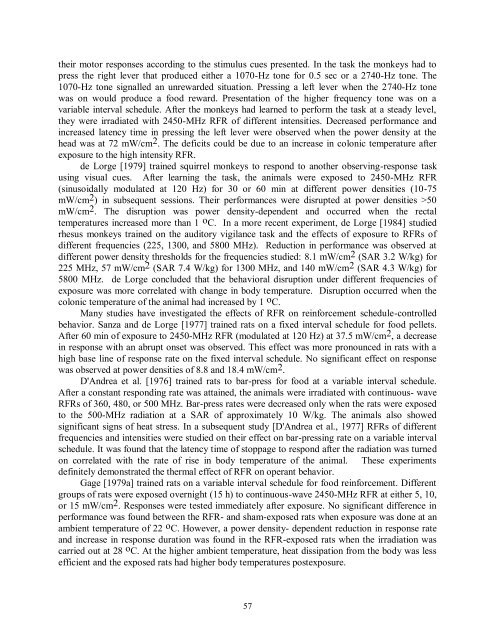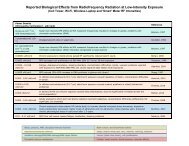Evidence for Effects on Neurology and Behavior - BioInitiative Report
Evidence for Effects on Neurology and Behavior - BioInitiative Report
Evidence for Effects on Neurology and Behavior - BioInitiative Report
You also want an ePaper? Increase the reach of your titles
YUMPU automatically turns print PDFs into web optimized ePapers that Google loves.
their motor resp<strong>on</strong>ses according to the stimulus cues presented. In the task the m<strong>on</strong>keys had to<br />
press the right lever that produced either a 1070-Hz t<strong>on</strong>e <str<strong>on</strong>g>for</str<strong>on</strong>g> 0.5 sec or a 2740-Hz t<strong>on</strong>e. The<br />
1070-Hz t<strong>on</strong>e signalled an unrewarded situati<strong>on</strong>. Pressing a left lever when the 2740-Hz t<strong>on</strong>e<br />
was <strong>on</strong> would produce a food reward. Presentati<strong>on</strong> of the higher frequency t<strong>on</strong>e was <strong>on</strong> a<br />
variable interval schedule. After the m<strong>on</strong>keys had learned to per<str<strong>on</strong>g>for</str<strong>on</strong>g>m the task at a steady level,<br />
they were irradiated with 2450-MHz RFR of different intensities. Decreased per<str<strong>on</strong>g>for</str<strong>on</strong>g>mance <strong>and</strong><br />
increased latency time in pressing the left lever were observed when the power density at the<br />
head was at 72 mW/cm 2 . The deficits could be due to an increase in col<strong>on</strong>ic temperature after<br />
exposure to the high intensity RFR.<br />
de Lorge [1979] trained squirrel m<strong>on</strong>keys to resp<strong>on</strong>d to another observing-resp<strong>on</strong>se task<br />
using visual cues. After learning the task, the animals were exposed to 2450-MHz RFR<br />
(sinusoidally modulated at 120 Hz) <str<strong>on</strong>g>for</str<strong>on</strong>g> 30 or 60 min at different power densities (10-75<br />
mW/cm 2 ) in subsequent sessi<strong>on</strong>s. Their per<str<strong>on</strong>g>for</str<strong>on</strong>g>mances were disrupted at power densities >50<br />
mW/cm 2 . The disrupti<strong>on</strong> was power density-dependent <strong>and</strong> occurred when the rectal<br />
temperatures increased more than 1 o C. In a more recent experiment, de Lorge [1984] studied<br />
rhesus m<strong>on</strong>keys trained <strong>on</strong> the auditory vigilance task <strong>and</strong> the effects of exposure to RFRs of<br />
different frequencies (225, 1300, <strong>and</strong> 5800 MHz). Reducti<strong>on</strong> in per<str<strong>on</strong>g>for</str<strong>on</strong>g>mance was observed at<br />
different power density thresholds <str<strong>on</strong>g>for</str<strong>on</strong>g> the frequencies studied: 8.1 mW/cm 2 (SAR 3.2 W/kg) <str<strong>on</strong>g>for</str<strong>on</strong>g><br />
225 MHz, 57 mW/cm 2 (SAR 7.4 W/kg) <str<strong>on</strong>g>for</str<strong>on</strong>g> 1300 MHz, <strong>and</strong> 140 mW/cm 2 (SAR 4.3 W/kg) <str<strong>on</strong>g>for</str<strong>on</strong>g><br />
5800 MHz. de Lorge c<strong>on</strong>cluded that the behavioral disrupti<strong>on</strong> under different frequencies of<br />
exposure was more correlated with change in body temperature. Disrupti<strong>on</strong> occurred when the<br />
col<strong>on</strong>ic temperature of the animal had increased by 1 o C.<br />
Many studies have investigated the effects of RFR <strong>on</strong> rein<str<strong>on</strong>g>for</str<strong>on</strong>g>cement schedule-c<strong>on</strong>trolled<br />
behavior. Sanza <strong>and</strong> de Lorge [1977] trained rats <strong>on</strong> a fixed interval schedule <str<strong>on</strong>g>for</str<strong>on</strong>g> food pellets.<br />
After 60 min of exposure to 2450-MHz RFR (modulated at 120 Hz) at 37.5 mW/cm 2 , a decrease<br />
in resp<strong>on</strong>se with an abrupt <strong>on</strong>set was observed. This effect was more pr<strong>on</strong>ounced in rats with a<br />
high base line of resp<strong>on</strong>se rate <strong>on</strong> the fixed interval schedule. No significant effect <strong>on</strong> resp<strong>on</strong>se<br />
was observed at power densities of 8.8 <strong>and</strong> 18.4 mW/cm 2 .<br />
D'Andrea et al. [1976] trained rats to bar-press <str<strong>on</strong>g>for</str<strong>on</strong>g> food at a variable interval schedule.<br />
After a c<strong>on</strong>stant resp<strong>on</strong>ding rate was attained, the animals were irradiated with c<strong>on</strong>tinuous- wave<br />
RFRs of 360, 480, or 500 MHz. Bar-press rates were decreased <strong>on</strong>ly when the rats were exposed<br />
to the 500-MHz radiati<strong>on</strong> at a SAR of approximately 10 W/kg. The animals also showed<br />
significant signs of heat stress. In a subsequent study [D'Andrea et al., 1977] RFRs of different<br />
frequencies <strong>and</strong> intensities were studied <strong>on</strong> their effect <strong>on</strong> bar-pressing rate <strong>on</strong> a variable interval<br />
schedule. It was found that the latency time of stoppage to resp<strong>on</strong>d after the radiati<strong>on</strong> was turned<br />
<strong>on</strong> correlated with the rate of rise in body temperature of the animal. These experiments<br />
definitely dem<strong>on</strong>strated the thermal effect of RFR <strong>on</strong> operant behavior.<br />
Gage [1979a] trained rats <strong>on</strong> a variable interval schedule <str<strong>on</strong>g>for</str<strong>on</strong>g> food rein<str<strong>on</strong>g>for</str<strong>on</strong>g>cement. Different<br />
groups of rats were exposed overnight (15 h) to c<strong>on</strong>tinuous-wave 2450-MHz RFR at either 5, 10,<br />
or 15 mW/cm 2 . Resp<strong>on</strong>ses were tested immediately after exposure. No significant difference in<br />
per<str<strong>on</strong>g>for</str<strong>on</strong>g>mance was found between the RFR- <strong>and</strong> sham-exposed rats when exposure was d<strong>on</strong>e at an<br />
ambient temperature of 22 o C. However, a power density- dependent reducti<strong>on</strong> in resp<strong>on</strong>se rate<br />
<strong>and</strong> increase in resp<strong>on</strong>se durati<strong>on</strong> was found in the RFR-exposed rats when the irradiati<strong>on</strong> was<br />
carried out at 28 o C. At the higher ambient temperature, heat dissipati<strong>on</strong> from the body was less<br />
efficient <strong>and</strong> the exposed rats had higher body temperatures postexposure.<br />
57



